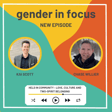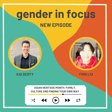
Building Trans-Inclusive Workplaces
In today’s episode of Gender in Focus, El and Kai dig into the cultural and structural barriers that prevent trans and non-binary folks from thriving in the workplace. From subtle everyday practices to long-standing institutional structures, these invisible forces can hold people back in ways we don’t often see. The key takeaway? Transforming a workplace takes time - and it’s all about making gentle, thoughtful shifts that lay the foundation for a more inclusive environment. You don’t have to overhaul everything overnight; small, intentional changes can create meaningful impact. Tune in for insights on how to begin breaking down those barriers, one step at a time, to help foster a truly inclusive workplace culture.
Get in touch: podcast@transfocus.ca
Join us on social media:
LinkedIn | Instagram | TikTok | Threads | Facebook



















